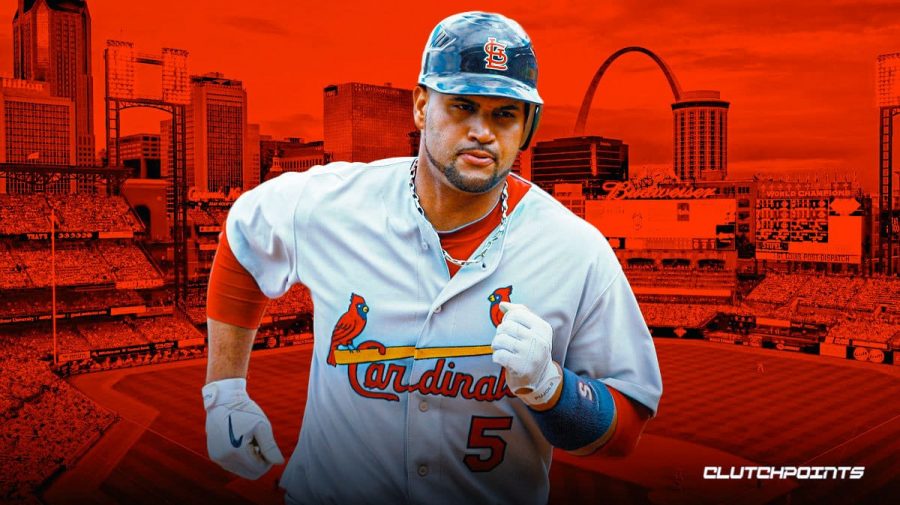Releasing Albert Pujols
May 13, 2021
This past Thursday marked an end to an era for baseball fans as Albert Pujols was designated for assignment by the Los Angeles Angels, or in other words, released from the team. This comes as a shock, as the first baseman is in his final year of his contract with the Angels, who signed him to a 10-year, $240 million deal in 2011. Pujols has been a once in a generation talent and with the Angels releasing him, it might mark the end to his illustrious career.
Pujols has spent the last nine seasons on the Angels, writing his name in the record books during this time. He had a .256 batting average while on the club and tallied 222 home runs in those nine years. This effort was headlined by the 2015 season, where Albert hit 40 home runs and hit for a .244 average. This statline for the season earned him a spot in the 2015 MLB All-Star Game, which would be his 10th appearance. Pujols’ main accomplishments in Los Angeles, however, were earning his 500th and 600th career home run and surpassing the 3,000 hit mark, all of which almost guarantee him a spot in Cooperstown. While Pujols still produced solid numbers on the Angels, he is not known for his time in Los Angeles. Where Pujols made a name for himself and started his Hall of Fame career was in St. Louis, where he was the star first baseman for the Cardinals. Pujols made his debut in 2001, which paved the way for an amazing rookie season. He tallied his first career hit on Opening Day, 2001, in Colorado against the Rockies, where he singled to center field off of Mike Hampton. Little did people know that this would be the first of his nearly 3,300 career hits. The remarkable thing about Pujols, however, is his ability to absolutely crush a baseball. He hit his first home run that season in Phoenix against the Diamondbacks, marking the first home run of his 667 total in his career. Hitting 37 home runs and with a batting average of .329, Pujols earned the honor of National League Rookie of the Year for 2001, won the National League Silver Slugger Award, and was selected to his first All-Star Game. This season was just the beginning for Pujols. Over the next 5 seasons, he hit 213 home runs, hitting over 40 each year for 4 of the 5 seasons. He had a batting average of over .330 from 2003-2006, even hitting .359 in 2003. Pujols was named the National League Batting Champion in 2003, a year in which he also won the National League Silver Slugger Award and the Hank Aaron Award. Pujols won his first National League MVP in 2005 and would go on to win the award 2 more times in 2008 and 2009. All of these awards, however, were all topped in 2006 when Pujols led the St. Louis Cardinals to their 10th World Series Title in franchise history, beating the Detroit Tigers. Pujols had now accomplished one of the most difficult tasks in all of sports, which was winning a World Series. In 2011, he won yet another World Series with the Cardinals, this time over the Texas Rangers in a series that took the whole 7 games. While the main story of the 2011 World Series was not Pujols, but rather David Freese’s heroics in Game 6, Pujols still contributed greatly to the success of the team. Sadly, 2011 was the last year in St. Louis for the slugger, and he would later sign with the Angels in free-agency. This leads us to where we are today.
With the release of Pujols comes a big question: should the Cardinals sign the first baseman to let him finish his career in the city that it all started in? In my opinion, this is a simple question to answer, and that answer is yes. As a lifelong Cardinal fan, I grew up watching players like Pujols wear the birds-on-the-bat across their chests and would love to see him finish his career in the Cardinal uniform. I think it would be a fairytale ending, as Pujols would come back and retire after this year, retiring as a Cardinal. This would be bittersweet, however, because this year likely is the last year for two more Cardinal legends: Adam Wainwright and Yadier Molina. Molina and Wainwright have been on the Cardinals for roughly 16 years, playing with Pujols from 2004-2011, winning both World Series alongside him. Seeing Molina, my favorite player, and Pujols, one of my favorite players, retire alongside each other is, in my opinion, the only correct way for both of them to retire. Whether or not this happens, Albert Pujols will always be seen to many as a baseball legend and possibly a top-3 first baseman of all time, but I will see him as more than that: a Cardinal legend that will be enshrined alongside other franchise legends in Cooperstown, New York.

